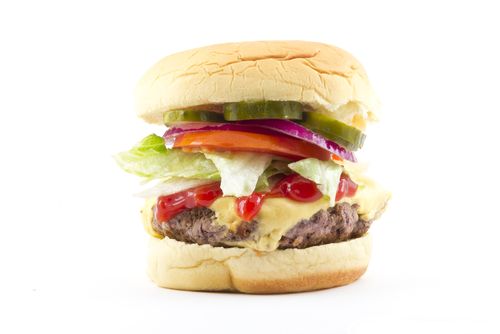Rachel Huddart explores the future of meat production in advance of our upcoming TalkScience event on 30th September. Tickets are available from the box office.
When was the last time you ate meat? Today? Last week? Never? For most people in the developed world, meat is a major part of their diet as well as their food culture. In 2009, the average Brit ate almost 85kg of meat a year - double the global average of 42kg1. As a result of this, by 2050, the global demand for meat is expected to be 73% greater than levels in 20102. How are we going to meet this demand?
It’s not easy being green…
We use one quarter of the land on Earth to raise more than 70 billion livestock animals and one third of the total available arable land to feed them3,4. Livestock rearing is the cause of about 80% of deforestation in the Amazon5. We know deforestation is a big driver of climate change and this is exacerbated by the fact that meat production accounts for 15% of total global greenhouse gas emissions6. Is meat worth all this damage or is there any way for us to reduce its impact on the planet?
Health risks
Several studies in recent years have linked red meat in particular to an increase in a person’s risk from certain types of cancer, cardiovascular disease and Type 2 diabetes7,8. On top of this, there are concerns that overuse of antibiotics in agriculture could lead to the evolution of more antibiotic-resistant bacteria, like MRSA. This could to lead to an increase in untreatable infections and deaths and make simple medical procedures potentially lethal.
So, what should we do? Studies suggest that reducing or completely cutting meat, or even just beef, out of your diet can drastically shrink your carbon footprint9. However, there are no signs that global meat consumption is going to start decreasing in the foreseeable future. Could technologies or alternative sources of food help to reduce the effects of meat production?

The burger - Environmental menace? Health risk? Or just delicious? (Copyright Macko Flower: Shutterstock)
Meat of the future?
Genetically modified livestock, like flu-resistant chickens, could reduce losses from disease and could also grow more efficiently, meaning less feed is required to get the animal to market weight. Others, like the Enviropig, could be engineered to be less polluting. GM technologies have come a long way since the 90’s and are now capable of making astonishingly precise modifications to an animal’s DNA10. But would we ever be completely happy to eat a GM sausage or would we prefer in vitro meat, like the “stem cell burger”11? Growing meat in a lab would massively reduce the number of animals we use as food (we’d still need some to provide the initial stem cells). However, that single burger cost £217,000 to produce and it’s unlikely that the process of growing cells will be easily scaled up any time soon. But how will we know that these technologies are safe and, even if they are, will we ever be happy to eat food produced in this way?
How about other sources of food? The idea of chowing down on a caterpillar might seem disgusting, but insects are high in protein, low in fat, and have a much lower environmental impact than livestock. Could we bypass the animal altogether and produce meat directly from plants12? Or give up plant and animal-based food altogether and eat synthetic food13? Is the only answer to go vegetarian?
What should we do?
How do we go about making changes? Should we, as consumers, vote with our wallets and just buy less meat? Can the food industry help by making meat-free alternatives more available and noticeable or should they price meat to reflect its true costs? Should the government, both at national and EU level, be more open to the use of new technologies or should they promote more sustainable farming methods? Whatever we decide to do, it’s clear that we need to make a decision soon to avoid any further damage to the environment and our own food supply.
Our 26th TalkScience event on September 30th will discuss the future of meat production with our expert panel of Professor Helen Sang(Roslin Institute, Edinburgh), Vicki Hird (Friends of the Earth) and Professor Richard Tiffin(University of Reading), chaired by Catherine de Lange(New Scientist). Tickets cost £5 and are available to book from the Box Office.
For those of you who can’t come along, we will be collecting questions before the event to ask during the debate. If you have a question for our speakers, send it to us by the 30th of September through our Facebook or Twitter pages using the hashtag #BLTalkScience. We’ll be live-tweeting the event using the hashtag, so you can follow the conversation wherever you are.
More reading
1) http://chartsbin.com/view/12730
2) http://www.fao.org/docrep/018/i3437e/i3437e.pdf
3) http://www.europarl.europa.eu/climatechange/doc/FAO%20report%20executive%20summary.pdf
4) http://www.ciwf.org.uk/media/3640540/ciwf_strategic_plan_20132017.pdf
5) http://www.ncbi.nlm.nih.gov/pmc/articles/PMC2373903/
6) http://www.unep.org/pdf/unep-geas_oct_2012.pdf
7) http://archinte.jamanetwork.com/article.aspx?articleid=414881
8) http://archinte.jamanetwork.com/article.aspx?articleid=1697785
9) http://www.theguardian.com/environment/2014/jul/21/giving-up-beef-reduce-carbon-footprint-more-than-cars
10) http://www.independent.co.uk/news/science/pig-26-can-this-little-piggy-win-over-the-enemies-of-gm-8574119.html
11) http://www.bbc.co.uk/news/science-environment-23576143
12) http://www.wired.com/2013/09/fakemeat/
13) http://www.newyorker.com/magazine/2014/05/12/the-end-of-food